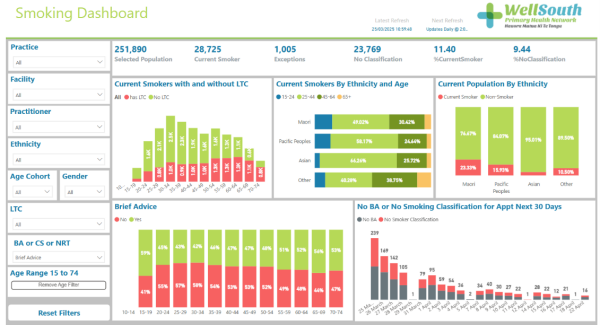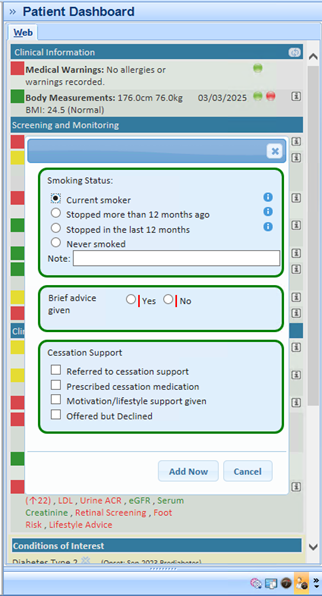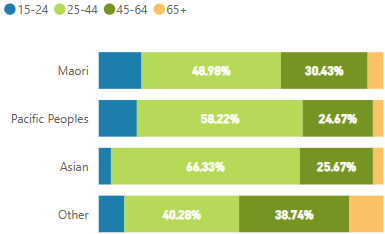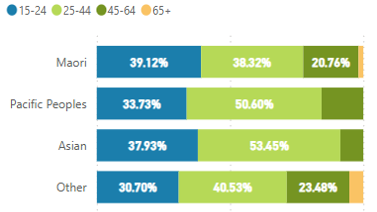Thalamus Dashboard
Here’s what the Smoking cessation dashboard offers:
-
Like our other dashboards, you can filter by age and ethnicity.
-
You’ll be able to identify patients who need a smoking read code and brief advice and have an appointment in the next 30 days.
-
You can prioritise smokers who are also living with a long-term condition.
-
Exception reporting will show you patients who were incorrectly reclassified from ‘current smoker’ to ‘never smoked’ and, as a result, missed receiving smoking cessation advice
If you have any questions, please email Glen Knol glen.knol@wellsouth.org.nz.

Coding and Data
Having accurate coding in your PMS helps to ensure that our understanding of smoking and vaping in our region is accurate, which in turn helps us to target our intervention and support.
In your patient dashboard (except for Profile for Mac practices) you can choose the smoking and vaping options available to you. This will ensure your individual practice’s data, as shown in the new smoking dashboard on Thalamus, is accurate (Thalamus a list of readcodes that are picked up in the Documentation).
If you have a HIP or health coach in your practice, talk to them about how they can support this mahi.

Southern smoking PMS Data
According to Patient Management System (PMS) records, over 28,000 people aged 15 and over in Southern are classified as current smokers, resulting in a smoking prevalence of 11.4%. The prevalence is notably higher among Southern Māori at 23.4% (5,643 people) and Pacific Peoples at 15.9% (1,046 people).
Men in Southern are 1.38 times more likely than women to be classified as smokers. Across all ethnicities and genders, smoking rates are highest in the 25–44 age group, as illustrated in Figure 1. This group also has the lowest rate of brief advice (BA) delivery, with 44% of smokers in this age range receiving BA.
Overall, BA was offered to 47.1% of people who smoke as of April 2024, a decline from 86.5% in 2019. Among ethnic groups, Māori had the highest rate of receiving BA (49.8%), while Pacific Peoples had the lowest (45.6%). Non-Māori, non-Pacific Peoples received BA at a rate of 46.5%.
The BA Number Needed to Treat (NNT) for self-reported smoking abstinence at six months is 73[1].
Figure 1. Current Smokers by Ethnicity and Age

According to PMS records, there are 8,488 current vapers, representing 3.4% of the population aged 15+. This is substantially lower than the 11.1% prevalence of daily vape use reported in a recent National New Zealand Health Survey[2], and likely reflects the fact that vaping PMS codes were only made available in November 2024. The Health Survey also found that vaping rates are particularly high among younger age groups, Māori and Pacific peoples, and those living in areas with higher levels of deprivation.
In Southern’s data, Māori have a vaping prevalence 2.2 times higher than non-Māori, non-Pacific peoples, while Pacific Peoples have a prevalence 1.4 times higher. Interestingly, vaping rates are similar between males and females. Although the 25–44 age group remains the most prevalent among vapers, there has been a notable increase in vaping among those aged 15–24 compared to smoking data, as shown in Figure 2.
Figure 2. Current Vapers by Ethnicity and Age

1] Cheng, C., He, W.J.A., Gouda, H., Zhang, M.J., Luk, T.T., Wang, M.P., Lam, T.H., Chan, S.S.C. & Cheung, Y.T.D. (2024). Effectiveness of very brief advice on tobacco cessation: A systematic review and meta-analysis. Journal of General Internal Medicine, 39(9), pp. 1721–1734.
[2] Nip, J., Edwards, R., Hoek, J. & Waa, A. (2024). Smoking prevalence and trends: important findings from the 2023–24 New Zealand Health Survey. Public Health Expert Briefing.